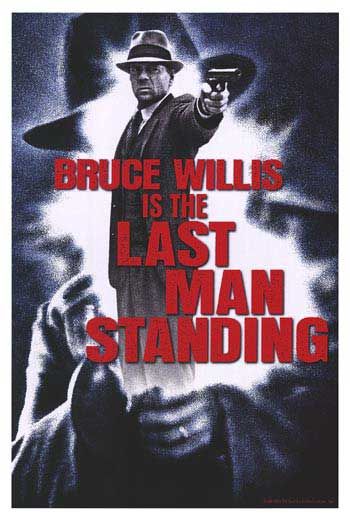

The criminal enterprise at issue is ostensibly bootlegging, but just like in every other iteration of this story, it hardly matters: The town of Jericho is a hole in the ground with maybe two or three citizens who aren’t pistol-packing outlaws.

There is a lot of it that is Western in feel-dusty streets and gun duels are constant features of the setting-but it’s told in the style of a noir right out of Hammett’s Prohibition-era milieu, complete with hardboiled narration courtesy of Willis. What’s different about this take is the framing and the genre. When asked for his name, Mifune blithely makes something up (he is inspired by the mulberry field he happens to glimpse out a nearby window). Willis’ nameless drifter comes to the same fork in the road that Toshiro Mifune’s wandering ronin does, but instead of tossing a stick to decide which way he’ll go, Willis spins an empty bottle of booze. Last Man Standing doesn’t quite adapt its influences shot for shot, but most of the plot beats and gimmicks are right where you expect them if you’ve watched Leone and Kurosawa. Very few films have made the attempt to do another retelling after Leone, though. You could find a lone samurai go up against outlaws and a grim dude slapping leather against criminals in literally the same weekend in 2004 if you happened to want to see Kill Bill Vol. You can find a protagonist without a name in literally the last thing I wrote about, or, say, Cormac McCarthy and Ridley Scott’s 2013 film The Counselor. Plenty of movies and directors draw from this same well all the time. Fans of the samurai and Western genres know the works that followed: Akira Kurosawa’s Yojimbo translated the story seamlessly into a story of Japan’s Edo period in 1961, and almost immediately afterward, Italian director Sergio Leone set the story in the American West and used it to turn Clint Eastwood into an international sensation in 1964’s A Fistful of Dollars. Dashiell Hammett’s character, the Continental Op, first played two sides against each other in the novel Red Harvest in 1929. If there’s a modern mythology, cinema’s “Man with No Name” is a part of it, another kind of hero with a thousand faces. And then: A drifter with a past we can only guess at, and a name we’ll never know, who stands in between. Innocent people who are “weakly caught in the middle,” forced to choose between evils in the battles of bad against bad. Two gangs, violent and callous, fighting over nothing that matters.


 0 kommentar(er)
0 kommentar(er)
